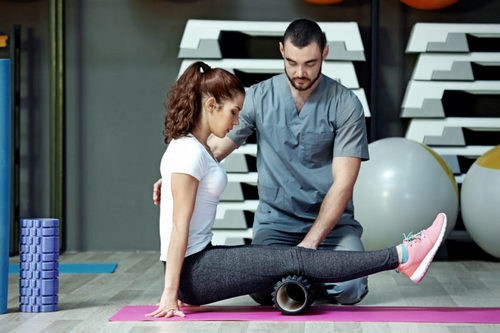Even in the days of Ancient Greece, it was known that physical exercises have a positive effect on the body and improve its functions. First of all, they improve the functions of the musculoskeletal system (mobility, range of motion, muscle strength) and cardio-respiratory functions (endurance).
In the middle of the XIX century, in different countries officially began to use structured physical exercises to achieve a therapeutic effect.
Somewhere this direction was more developed (Sweden became the flagship at the time), somewhere it appeared later and was not so popular (for example, in Russia).
Classification of exercise therapy: forms and means
The following forms of exercise therapy are officially distinguished:
- morning gymnastics;
- physiotherapy;
- dosed walking;
- production gymnastics;
- medical swimming;
- hydrokinesitherapy;
- mechanotherapy;
- occupational therapy, training in household skills and walking;
- games, sports games;
- tourism;
- terrenkur.

The means of exercise therapy include:
- physical exercise;
- exercise in water;
- walking;
- climbing
- training on simulators;
- swimming.
But, in my opinion, these classifications are unjustified. Morning exercises may well be therapeutic, and walking is one of the options for exercises (why it stands out in a separate form is also not clear).

A more logical classification is the division of exercises according to the degree of inclusion of a person in them:
- exercises that a person can perform actively;
- exercises that a person cannot independently perform, that is, “active with the help of” – for example, a person can bend his arm, and is already unable to unbend it;
- passive exercises.
In which branches of medicine is exercise therapy used
In Russia, physiotherapy exercises are used:
- in neurology;
- in cardiology;
- in pulmonology;
- in traumatology / orthopedics;
- in nephrology;
- in pediatrics (in pediatric practice, the use of active exercises according to the instructions of a specialist is usually limited by the age of the child – up to 5 years old children poorly follow formal instructions, so passive exercises are often done).
With regard to gynecology, in Russia in this area exercise therapy is not used – in women’s clinics there are no specialists in physiotherapy exercises. Although in Western countries therapeutic (therapeutic) exercises in this area of medicine are used very widely.
If we compare how therapeutic exercises are used here and in the West, then there is a difference not only in the areas of application. So in the Western concept, therapeutic exercises include not only structured, familiar exercises, but also functional movements. For example, a person has a spinal injury, due to which the body does not work below the lumbar region.
In our country, in physical therapy classes, he will be given exercises for the development of the upper limbs and exercises for the press, and in Western institutions he will be prescribed exercises related to real movements and involving really necessary muscles. So, a person can be taught to change from a stroller to a bath and vice versa. In fact, during these movements, the patient will train the strength in the muscles of the hands, but unlike, for example, the well-known exercises with dumbbells,

– To engage in physical therapy for preventive purposes does not make sense. It is only needed for those who have health problems.
How to become a specialist in physical therapy and where to go to study
In order to become a specialist in exercise therapy, you must first graduate from a medical university. After that, you can go to specialized courses in physiotherapy and sports medicine or continue to study in residency (as I did).
In the near future, the training system will change. The name “exercise therapy specialist” will gradually become a thing of the past, and the specialty “physical therapist” will appear.
What is the responsibility of an exercise therapy specialist
This doctor examines the patient and prescribes various procedures for him. For example, you can prescribe individual or group physical therapy exercises (if the institution has a pool – hydrokinesitherapy). Sometimes he can prescribe a massage (in some hospitals it belongs to the competence of specialists in exercise therapy, in others it belongs to the competence of a physiotherapist).

The doctor himself does not conduct classes – this is done by instructors in exercise therapy or methodologists. When all the procedures have been completed, the doctor once again looks at the patient and, if there are improvements, writes out. Unfortunately, often the doctor does not evaluate the changes that have taken place with objective methods: he does not do tests for walking speed and stride length, he does not do gait and mobility tests. It is simply limited to the assurances of the patient that he has become better.
No matter how strange it may sound, the duration of the exercise therapy course does not depend on a specific problem, but on the structure of the medical institution itself. Have you been admitted to the rehabilitation department for 21 days? Then you will be rehabilitated for 21 days (and this despite the fact that you may need rehabilitation within three to four months). Came with an undeveloped elbow to the clinic? You are likely to be prescribed ten treatment procedures – and that’s all.
How does a patient go to a physical therapy specialist
In Russia, such a doctor sees a patient only when the attending physician sends him (the patient). This is very bad. In many clinics, people do not receive rehabilitation assistance, since a surgeon, for example, may consider that in the first days after surgery no one should approach the patient. In the West, physical therapy is the first contact specialty. On the very first day after surgery, a physical therapist comes to the patient.
For example, a leg has been amputated for a person, and the surgeon may not follow what posture he is in after the operation (this is not his area of responsibility), and this is important for future prosthetics. It is important that the leg is in the correct position, so that the person stretches those muscles that remain. This should be monitored by a separate specialist.
How physical therapy differs from exercise therapy
Physical therapy is a medical and social specialty aimed at helping people who have reduced mobility, impaired movement and limited motor capabilities.
A specialist in physical therapy understands how to safely increase human activity, understands rehabilitation and prosthetics. Specialist in exercise therapy understands only the exercises. Moreover, the physical therapist assesses the condition of the patient, draws up a treatment plan, implements it, and then evaluates the effectiveness. A specialist in physical therapy prescribes treatment, at best evaluates the effectiveness, and the procedures themselves are carried out by another person who often does not have a higher education, a methodologist or an instructor.
Physical therapy is based on a scientific approach and the principles of evidence-based medicine.
– In Russia, only 30-40% of what is used in the field of rehabilitation is based on the principles of evidence-based medicine.
Specialists in exercise therapy in our country often use proven methods that they think are reasonable. Our specialists do not have the skills to evaluate the proposed methods and proposed approaches.
Yes, in Russia a lot of research has been done in the field of rehabilitation. However, for the most part they were carried out poorly. Therefore, speaking of evidence-based medicine, we cannot take them into account.
Why exercise therapy can not do it yourself
Physiotherapy exercises should be supervised by a physician. Imagine this situation: mom watched a YouTube video on how to stretch a child with cerebral palsy. She began to repeat, pressed the leg in the wrong place and broke it. Or grandmother’s plaster was removed after a fracture in the elbow joint. Grandfather watched the video on the Internet and began to develop her wrist joint. He pressed harder and broke his grandmother’s hand.

Doctors are taught the technique of manual handling of patients: where to get it, how to get it, where you can push it, where you can’t, what is the biomechanics of movements.
How to distinguish a physical therapy specialist from a charlatan, what to look for
- “Unique authoring technique. Only in our medical center ”- after hearing something like this, be sure to ask where the research results are published that confirm the effectiveness and safety of the method. If they are absent and they answer you that they say there is no time to engage in scientific research, then leave. Now the level of knowledge is such that it is very difficult to discover something fundamentally new. Most likely, in such a center you will simply be maimed.
- If you are told: “Look, we have a lot of research on our site”, do not be too lazy to at least see what it is about. Most likely, you will see only speeches at conferences or a monograph printed in small print runs. The statement “ten years of research is underway” also says little. Often, a company producing a particular product and service itself finances such research.
- The patient must have at least general information about his illness. For example, if a child is diagnosed with cerebral palsy, parents need to read about this condition. And if you know that you have a disease that cannot be cured (the consequences of a stroke, multiple sclerosis, cerebral palsy), and you are told that there is a certain technique that guarantees a 100% cure, then run away!



